Archived Article Detail
By Thomas P. Moore
WHAT’S NEW IN THE MINERAL WORLD ARCHIVE – posted on 10/25/2007
October 25, 2007
Those who don’t know the codes of the mineral world might want to call this simply the Autumn Installment of “what”s new online,” but we know, of course, the significance of October: it sees the last fallout from Denver, it leads up to Munich, and the is even perhaps an early, high-flying whiff of Tucson in the bracing air. So I hope everyone is in the mood to read some results of a late-October surveillance of ….
What”s New On The Web
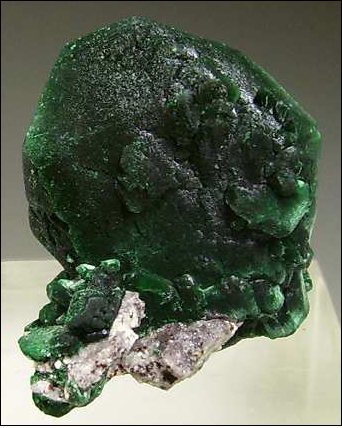
Sonora, Mexico. John Veevaert specimen and photo.
Many of you will already have heard heavy rumors about fine azurite and pseudomorphous malachite specimens from a new locality in Sonora, Mexico. While some facts about the occurrence have not yet been prodded out of the chute and into the roaring arena of Full Disclosure, don’t worry, we’ll soon be better informed, perhaps with the help of a brief article in the Mineralogical Record. Subscribers meanwhile will see some beautiful azurite specimens from the occurrence pictured with the Denver Show report in November-December 2007. At that show, Rob Lavinsky had five wonderful cabinet-size azurites just up from Mexico, and Evan Jones offered several flats of miniatures of the malachite pseudomorphs. Very likely this will turn out to be a world-class locality for the two copper carbonates: we do know that it’s near Cananea, Sonora, and is called the Milpillas mine. I mention it in the present “online” context because John Veevaert of Trinity Minerals has picked up some malachite pseudomorphs from Evan Jones, and is offering them on his site (www.trinityminerals.com), and as far as I know this is the first web-marketing of material from the occurrence. (However, a late bulletin: on October 23, just as I”m finalizing this report, two excellent miniature malachite pseudomorphs and a spiffy miniature azurite from the Milipillas mine have been posted by Dan Weinrich: www.danweinrich.com). As the picture shows, the tabular malachite pseudocrystals are quite sharp, stand up smartly, and boast surfaces of a rich, almost chatoyant, dark velvety green.
In still another coup, John Veevaert picked up two proud web pages’ worth of fine, classic old specimens from the Philadelphia Academy of Natural Sciences collection, procuring a few pieces each from the three dealerships involved in the Philly Collection transaction (by now a familiar story which need not be repeated). After looking through this selection of venerables now in John’s hands, I had some trouble deciding which to show here, and I hope you approve of my two choices. The paravauxite miniature was shipped to Philly during the 1929-1930 Vaux-Philadelphia Academy Expedition to Bolivia, when Samuel Gordon dug in the Siglo XX mine what would become the type material of the “three vauxites,” vauxite, paravauxite and metavauxite. The august, dignified (if just slightly dinged) old galena pseudomorph after pyromorphite is from (pay attention, now: this locality designation is often mangled in frightful ways) the Kautenbach mine near Bernkastel-Kues in the Moselland, Rhineland-Pfalz, Germany. 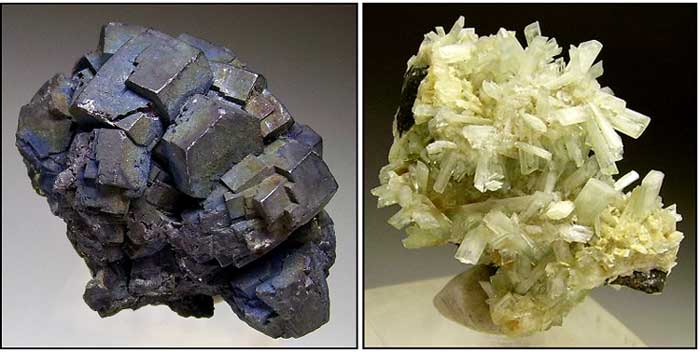
Right: Paravauxite, 3.8 cm, from the Siglo XX mine, Llallagua, Bolivia. Former Philadelphia Academy of Natural Sciences collection. John Veevaert specimen and photo.
Unusual and oddly beautiful specimens of vesuvianite have been coming of late from the Alpine-type clefts near Alchuri, Shigar Valley, Northern Areas, Pakistan (for descriptions of this occurrence, see the articles by Dudley Blauwet and Wendell Wilson respectively in November-December 2006). The specimens in question show vesuvianite as sleekly lustrous, short-prismatic, lightly striated, red-brown to maroon crystals to 2 cm or so, many with thin white fringes ringing the basal pinacoid terminations; these fringes, we”re told, are not composed of another species, but of finely fibrous growth domains of the vesuvianite itself. The little white-fringed, rootbeer-barrel-like crystals make for very appealing specimens, and you’ll find an appealing selection of them on Mike Keim’s Marin Minerals site (www.marinmineral.com). Mike offers loose vesuvianite crystal clusters to medium-miniature size, some with sharp, lustrous clinochlore “books” standing edgewise in dense groups, the clinochlore crystals reaching 1.2 cm individually. According to Mike these specimens are from a “recent find” at Alchuri, and this seems likely, as neither clinochlore nor vesuvianite of the white-fringed type is mentioned in Wilson’s 2006 survey of Alchuri material. 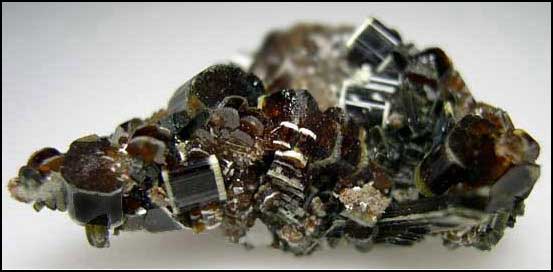
The Marin Minerals site further boasts about 20 superb small specimens, mainly African, from the collection of German/South African collector Wolfgang Pohl. Andrei Rykoff of AA Rockshop (www.aarockshop.com), as well, has secured (through Scott Werschky of Miner’s Lunchbox) some small but outstanding specimens from the Pohl collection—the hausmannite from the N’Chwaning II mine, Kuruman manganese district, Northern Cape Province, South Africa, shown here, should give some idea of the quality we are talking about. Thus the Pohl collection joins quite a few other superb private collections which for one or another reason are being recycled right now, enriching shoppers’ choices both on the web and at major shows. Indeed, the traffic in these older collections seems heavy enough to suggest that the mid-2000”s era of mineral collecting will someday be judged as a time just as much of exciting recyclings as of abundant new discoveries…what”s that Wendell Wilson likes to say about how we live in a golden age of mineral collecting? Better believe it.
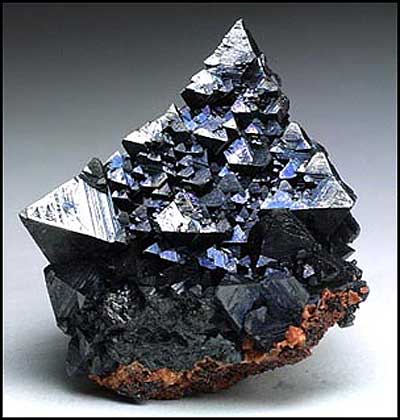
Chris Wright of Wright’s Rock Shop (www.wrightsrockshop.com) has at least three interesting new-discovery-type lots of specimens on his site. First, there is fluorapatite, and that of two remarkably different styles, found last July in a huge pocket in the Sapo mine, Minas Gerais, Brazil. At the 2007 Denver Show the main man for these new fluorapatites was their importer, Brazilian dealer Luis Menezes, but Chris was one of the very few other dealers who also offered fine examples. Not to be confused with the hydroxyl-apatite (yellow-green discoidal crystals on microcline) already known from the Sapo mine, the new fluorapatite occurs as lustrous, razor-sharp, translucent blue-green tabular crystals to 2.5 cm or so and as odd stalactiform aggregates of transparent pale yellow crystals in parallel growth, to more than 8 cm long. You can check out the upcoming Denver report for fuller descriptions of these fine specimens, and meanwhile you can check out the Wright’s Rock Shop site. Next, Chris has miniature-size specimens from a new find of the rare aluminum phosphate planerite (of the turquoise group) from a collecting site near the Mona Lisa mine, Polk County, Arkansas. Baby-blue coatings, intergrown hemispheres and tiny columnar aggregates of planerite microcrystals coat wavellite of the familiar “Arkansas” type, on rusty pale brown (iron oxide-infused) quartz matrix. Finally, Chris offers a few enigmatic specimens from a new find of barytocalcite at a locality given, unfortunately, only as Yunnan Province, China. The photos on the site show slender, spiky, translucent yellow-brown crystals to 2 or 3 cm standing up at various angles from matrix.
More than once before in this space I have mentioned the Spanish dealership run by Felix Garcia Garcia and somewhat surprisingly called Edelweiss Minerals: Felix is a fan of Swiss Alpine clefts and often has very nice, recently dug examples from the Swiss Alpine suite. This time, on his site (www.edelweissminerals.com), you can see the remainders of a little hoard (first posted in August) of fluorite specimens from two recently opened clefts in the Grimsel area, on the border between Bern and Wallis (Valais) cantons. Transparent, octahedral pink crystals to 2.5 cm, of slightly rough aspect and with relict coatings of yellowish matter somewhat masking their beauty, come from the Zinggenstock: these are loose, floater crystals and small crystal clusters on matrix. More attractive and more interesting-looking are specimens from a cleft near the Oberaargletscher, these showing transparent, pale blue-purple cuboctahedral crystals of fluorite to 2.5 cm sitting pertly, as singles or clusters, on granitic matrix; the matrix itself features scatterings of microcrystals of anatase and fluorapatite. If your knee-jerk belief is that Swiss fluorite, to be desirable, must be pink and octahedral, look at the picture of one of Felix’s best specimens of the purplish Oberaargletscher material. Oh yes, and the site also offers, as it frequently has in the past, thumbnails and miniatures showing brilliant black, platy hematite crystals with epitactic rutile from (you guessed it) the Cavradi gorge, Tujetsch (older name: Val Tavetsch), Canton Graubünden, Switzerland. 
In the September-October 2001 issue of our magazine, Marco Marchesini and Renato Pagano offered a long and surely “definitive” article on the Val Graveglia mining district, Liguria, Italy. Active exploitation of manganese ore in the district is finished now, but avid Italian collectors still once in awhile make interesting dump finds of Val Graveglia’s rare secondary manganese species of which the best known, and typically prettiest in macrospecimens, is tinzenite. Well, right now the Italian dealership Webmineralshop (www.webmineralshop.com) is offering about a dozen cabinet-size tinzenite specimens found five years ago in a “last strike” in the Molinello mine in Val Graveglia. The pale orange, very thin, platy tinzenite crystals in rosettes to a few millimeters across are scattered on wide matrix plates, associated with microcrystals of super-rare manganese-bearing species such as surssasite and ganophyllite. These, granted, are not topmost-quality tinzenite specimens (indeed they look pretty sad when compared to the superstar from South Africa shown on our July-August 2007 cover), but this seems a good time anyway to acquire a presentable tinzenite from Val Graveglia, since, probably, no more of this size will ever be found.
Adam Wright of The Adelaide Mining Company (www.theadelaidemine.com), recently cited in this space for a major strike of crocoite in the famous Adelaide mine, has nice specimens of hematite-included quartz from two little-known Tasmanian occurrences. Adam says that people have been digging specimens for many years from quartz veins cutting chloritic schist at a place called Philosopher’s Ridge, above the old Mt. Lyell copper mine and next to an old open cut. Doubly terminated floater quartz crystals, some with sceptered ends, from Philosopher’s Ridge get to be only 2 cm long at best but are sharp, lustrous and pretty, and some show inclusions of chlorite and/or chalcopyrite as well as hematite, and some have attached microcrystals of anatase. The second quartz locality is called, for short, Mt. Read: collecting in the very large area which this term indicates began about seven years back, at a specific site whose location is still a secret (at least to Adam). Opaque brick-red to transparent pinkish, prismatic quartz crystals from “Mt. Read” reach more than 15 cm long, and many are sceptered; there is a strong resemblance to the much more familiar specimens from the Orange River mouth area of Namibia/South Africa, except that Mt. Read specimens are much richer in associated species, with fluorite, calcite, dolomite, pyrite, chalcopyrite, and anatase, among others, being seen both as inclusions and as overgrowths. Adam Wright opines that this location could produce “some of the nicest quartz crystals in the world” if it can ever be mined properly, but meanwhile we’ll have to settle for the small handful of pieces now available on his site.
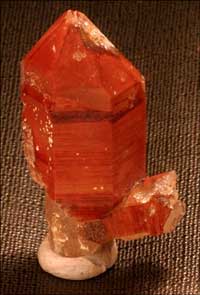
Mike Walter of Nicholville, New York operates a modest-but-fun site called Geologic Desires (www.geologicdesires.com), strong on things which Mike has collected himself, especially in far-upstate St. Lawrence County. This whole past summer he worked at the old, half-forgotten Dana locale of Pitcairn, St. Lawrence County, with excellent results, hitting a seam in the skarn which produced about 30 Manebach and Carlsbad-twinned crystals of albite to 5 cm, as well as sharp, lustrous, deep grayish green, doubly terminated crystals of diopside to 6 cm—the latter from what he calls the “Lunch Break Pocket.” The Pitcairn locality has been worked for specimens since the mid-19th century, and is even now open for a $5/day digging fee; its finest known diopside crystals exceed 12 cm and are among the best ever found in the United States. But you certainly could do worse than acquiring one of Mike Walter’s “lunch break” pieces such as the one shown here. 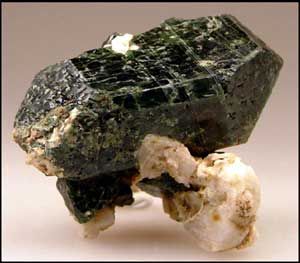
New York. Mike Walter specimen and photo.
Another site new to me this time around is that of Dave and Barbara Pfaff’s Dabar Minerals (www.dabarminerals.com), this one also highlighting self-collected pieces. The proprietors write on their home page that they have”…collected and traded minerals for many years and have now retired…we are hoping to find homes for [our specimens] with people who will enjoy them as much as we have. Most were collected in the 1970’s at many locations that are no longer open to collecting.” For instance, there are many things from familiar collecting sites in Ontario, including fine fluororichterite from Earle’s Farm near Wilberforce; there are excellent smoky quartz miniatures from Government Pits, North Conway, New Hampshire; there’s pretty prehnite both from Paterson, New Jersey and Woodbury, Connecticut; and, most impressively, there are excellent old calcite specimens from the Pugh quarry, Custar, Ohio (closed to collecting in the mid-1970’s), and equally fine celestine specimens from the quarry at Lime City, Wood County, Ohio (closed in the late 1990’s). The Pugh quarry calcites show sharp, complete, translucent deep orange, just slightly rough-surfaced scalenohedral crystals to more than 12 cm; one cluster of undamaged crystals measures 14 × 21 cm ($500), and a fine thumbnail with a pristine, doubly terminated scalenohedron on matrix costs only $20. The Lime City celestine specimens, some with little white bursts of strontianite crystals, are mostly cabinet-size clusters of pale blue, lustrous, bladed crystals on matrix for under $100. On this likable site the Pfaffs also advertise rare back issues of Rocks & Minerals which were rescued from the famously cluttered house in Peekskill, New York once dwelled in by founding editor Peter Zodac (1894-1967).
While on the subject of classic U.S. localities I’ll mention something actually new from one of them: superb, outstanding, world-class (although, frankly, ugly) crystals of lithiophilite found early in 2007 in the Emmons quarry on Uncle Tom Mountain near Greenwood, Oxford County, Maine. This primary phosphate is found in phosphate-rich, gem-bearing pegmatites like those in Oxford County, in association with triphylite, its iron analogue—but almost never as euhedral crystals. The specimens from the new discovery, however, are fairly sharp, blocky lithiophilite crystals to 7.5 cm embedded in pegmatitic matrix; the crystal surfaces are slightly altered to purpurite, imparting a blue-gray color and faint silky sheen. A handful of these most unusual specimens appeared a few months ago on Rob Lavinsky’s Arkenstone website (www.irocks.com), there to tempt phosphate and Maine-pegmatite collectors.
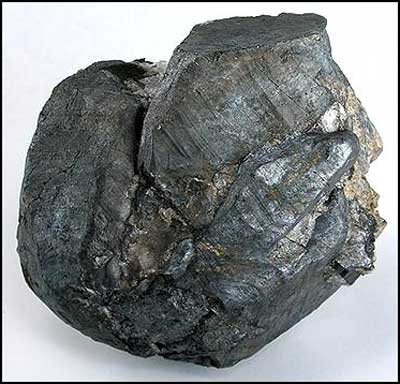
Before finishing—strongly, I hope—with Chinese desirables, I’ll acknowledge Emanuele Marini’s Demineralia (www.demineralia.com) for its fine, energetically diverse selection of what’s-news from many places. This labyrinthine site is especially strong, naturally, on Italian minerals, and thus it’s hardly surprising that many exceptional specimens from the new strike of sulfur in Sicily (see the July installment of this column) are presently being offered. But also there are fine sturmanites from the N’Chwaning I mine, South Africa; rarities from Madagascar; excellent specimens from Mt. Malosa, Zomba, Malawi, including not only predictable items like aegirine and arfvedsonite but also what must be one of the world’s best specimens of the very rare niobophyllite; a few of the new elbaites on feldspar from Burma, with lustrous “moor”s-head,” i.e. black-tipped, pinkish prisms; and a downright drooly thumbnail of andradite (“demantoid”) from the new strike at the Thetford mines in Quebec. All of these and more are priced reasonably, but remember that the prices are in Euros…the Euro/dollar rate as of October 16 is a disheartening € 1 = $1.41. During my coming trip to the Munich Show, it looks like I will not be able to afford champagne; I’m going to have to drink beer.
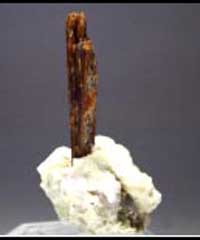
On the way to China, if you don’t mind, one quick stop in Brazil and then one in Afghanistan, courtesy (again) of Rob Lavinsky’s Arkenstone site. Rob is now showing large specimens—to almost 19 cm across—from a brand-new strike of yellow lepidolite in a pegmatite somewhere near Itinga, Minas Gerais, Brazil. Highly lustrous, pale to medium yellow, translucent rosettes of lepidolite form thick encrustations on single crystals and crystal groups of transparent and colorless quartz. These are beautiful, flashy and wholly “different” specimens of the humble mica, and probably the original lot, if not gone already, will not linger long in Rob’s shop. The same goes for three new, also large—to 16 cm—lepidolite specimens from Pech, Kunar, Afghanistan which Rob is also offering. These specimens are mounds of rhythmic wavecrests of solid, pale lavender lepidolite overgrowths on albite, with a few pale elbaite crystals sticking out here and there: could they really be the first noteworthy lepidolite specimens from Afghanistan”s pegmatites?
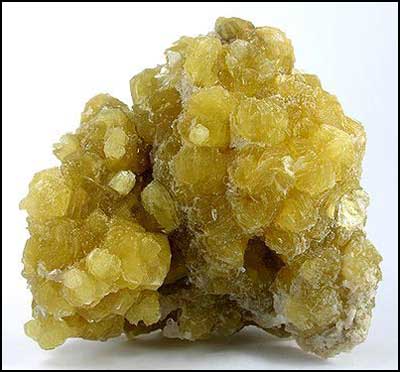
Then there are the new fluorite specimens of the “turtle shell” sort which hail from somewhere in China and which we started seeing at the 2007 Tucson Show. At that time nobody, not even Rob Lavinsky, who had the best of them, could provide a locality designation beyond “Jiangxi Province,” but Rob has more turtle-shell fluorites now, and if his informants are right the locality isn’t in Jiangxi at all but rather is a place called Minggang, Xinyang, Henan Province. In all likelihood the mystery is not yet definitively resolved, but anyway the translucent purplish blue, smooth-surfaced fluorite spheres and ovoids look very nice when strongly backlit, as the photo here shows. The specimens in Rob’s present small batch range in size from thumbnail through large-cabinet. 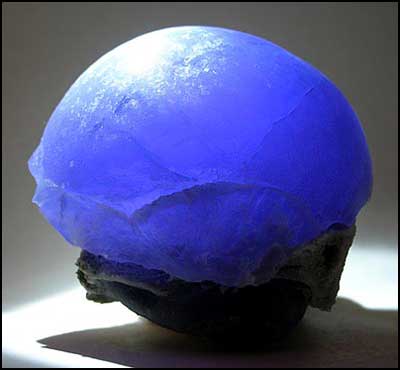
The open-air specimen diggings on wooded hillslopes between the towns of Tongbei and Yunling, Fujian Province, China have been giving forth beautiful specimens, particularly of brilliant red-orange spessartine crystals blanketing smoky quartz crystals, since the late 1990’s: the best account is the one by Berthold Ottens in January-February 2005 (our first China Issue). It appears, though, that locality-mortality is about to catch up with this already famous place. One of the two productive digging sites is owned by dealer Chen Weigang, who explains in a September update to his TC Mineral-China website (www.mineral-china.cn or www.china-mineral.cn) that the excavation has now reached more than two-thirds of the way up from the base of the hill to its peak, and that rubble is piled so high at the base, with no roads over which it might be trucked out, that collecting work is being seriously hindered. Also, the Collector’s Edge dealership, well connected in China, reports that Tongbei-Yunling is “in its last phase of production,” as Tom Gressman puts it. This news should enhance our interest in the 6 “rooms” of Tongbei-Yunling specimens on the TC Mineral-China site—Mr. Chen has been hoarding these specimens, and says that they represent the best of the past several years’ accumulation. In varying combinations these pieces display the full range of minerals from the occurrence, including spessartine, quartz, orthoclase, muscovite, pyrite, hematite, blue-purple fluorite and mustard-yellow helvite. Collector”s Edge notes that the smoky quartz crystals which are overgrown by relatively small, pale spessartine crystals commonly are themselves highly lustrous and fully as gemmy as the best Swiss smoky quartz—and yes, on the Chinese site there are gemmy smoky quartz crystals to 11.5 cm long in magnificent groups. On hand also with Mr. Chen are specimens showing the best octahedral blue fluorite crystals yet to appear from Tongbei-Yunling, and there are sharp, red-brown, trapezohedral spessartine crystals to 3 cm in loose, monomineralic clusters, and there is one exceptional thumbnail consisting of a 1.7 × 2.6 × 2.9-cm helvite crystal with a little bloom of orthoclase crystals attached.
However, the most interesting section of TC Mineral-China at present is devoted to specimens from a small mine where commercial work ceased 12 years ago: the Shangbao mine, which exploited a pyrite orebody in a skarn about 30 km southeast of Leiyang, Hunan Province. Shortly before its closure in 1995 the Shangbao mine produced fair numbers of very beautiful fluorite specimens, with many-hued, transparent, cubic crystals (many with dodecahedral bevels) included by sharp, bright pyrite cubes and by milky quartz prisms. After 1995 a group of former miners took out small numbers of collector and “decorator” specimens; best known, besides the fluorite, are specimens showing simple, lustrous, cubic pyrite crystals to several centimeters on edge, peculiar specimens of “artichoke quartz,” and matrix plates from which rise forests of sceptered milky quartz crystals which touch at canopy level. Now, with Mr. Chen’s specimens, we have what seems all possible combinations of sharp pyrite cubes; pearly, saddle-shaped dolomite crystals to 1 cm and snowball-like dolomite spheres to 2.5 cm diameter; complex, rough-surfaced, transparent pale blue fluorite crystals to 4.5 cm, some with movable water bubbles; jamesonite as inclusions in the fluorite or forming fuzzy “nests” on which the dolomite rests; and clusters of curving, tapering, compound crystals, to 8 cm, of what Mr. Chen calls “green quartz” (though it looks more bluish in some of the pictures) in cactusy-looking groups. The three pictures here—pyrite/dolomite, fluorite/dolomite, and an attractive cabinet-size group of spindle-shaped “green” quartz crystals—will give some idea of the variety of this material. 
A Museum Note
There is only one bit of news from the world of natural history museums to pass along. Ellen James, Communications and Media Relations Manager of the Carnegie Museum of Natural History, Pittsburgh, would like everyone to know that a major new addition to the museum’s Hillman Hall of Minerals and Gems officially opened on September 28: it is the Wertz Gallery of Gems and Jewelry, named in honor of Ronald W. Wertz, longtime president of the Hillman Foundation (principal benefactor of Hillman Hall). This 2000-square-foot addition will be used to display the museum’s 500-piece collection of faceted gems and jewelry, including many items which have never before been shown publicly. Among the dedicated cases are those (this is just a sampling) on jade; beryl as a gemstone; quartz as a gemstone; diamond replicas; birthstones; ruby spinel; tourmalines of Brazil; treated and synthetic gemstones; lapidary craft (carvings and semiprecious gem art); and lapidary art (precious and semiprecious gem art and jewelry). In addition to the permanent displays, the Wertz Gallery will host special temporary and traveling exhibits, the first of these being Luxe Life: Masterpieces of American Jewelry.
Hillman Hall, where the Carnegie Museum’s world-class mineral collection has been displayed since the early 1980”s, closed temporarily in early 2006 to allow for expansion and renovation of the displays and to enable construction of the Wertz Gallery. Now it is open again, and mineral curator Marc Wilson assures us both that the new Hillman Hall is more dazzling than ever, and that “The specimens in Wertz Gallery will be some of the finest on exhibit anywhere in the country…The entire exhibit gallery will be sparkling with top-quality stones and jewelry from world-renowned artists.” So, having booked your Christmas-season trip to Pittsburgh, know that the Carnegie Museum is open Tuesdays through Saturdays from 10:00 a.m. to 5 p.m. and Sundays from noon to 5:00 p.m.; and from 10:00 to 5:00 on the Monday of the week between Christmas and New Year”s and on Martin Luther King Day and President’s Day. After November 21, admission will be $15 for adults, $12 for senior citizens, and $11 for children aged 3-18 and full-time students with ID. For more information, visit www.carnegiemnh.org or call 412-622-3131.
For more information in this space, probably, you will have to wait until January, or, more to the point, The Month Before Tucson. Happy holiday season to all!
For questions about this column, please email Tom Moore.
